Recreation and Music
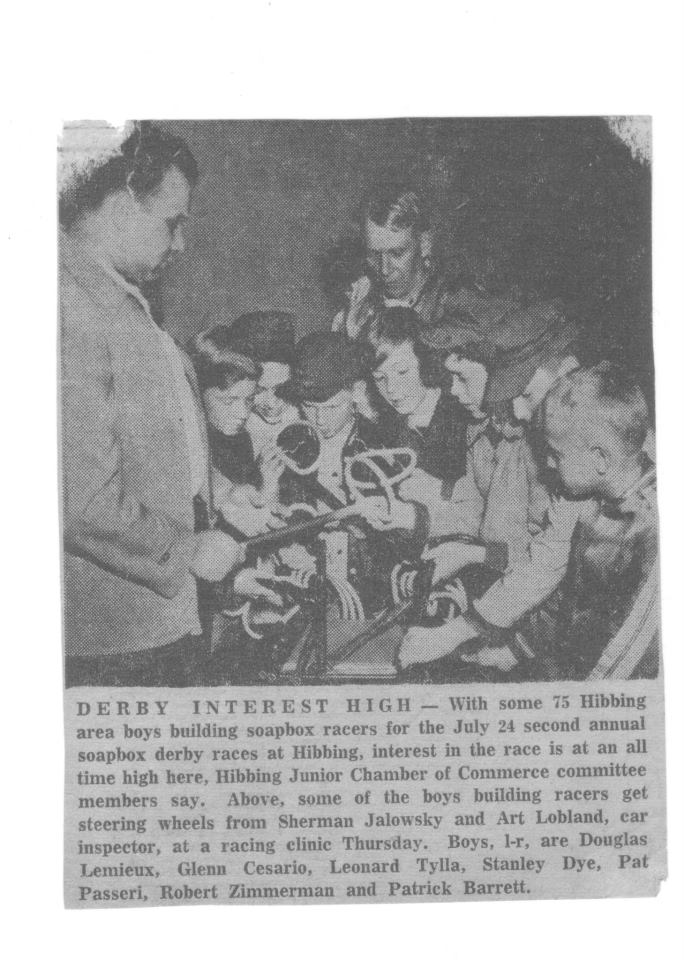
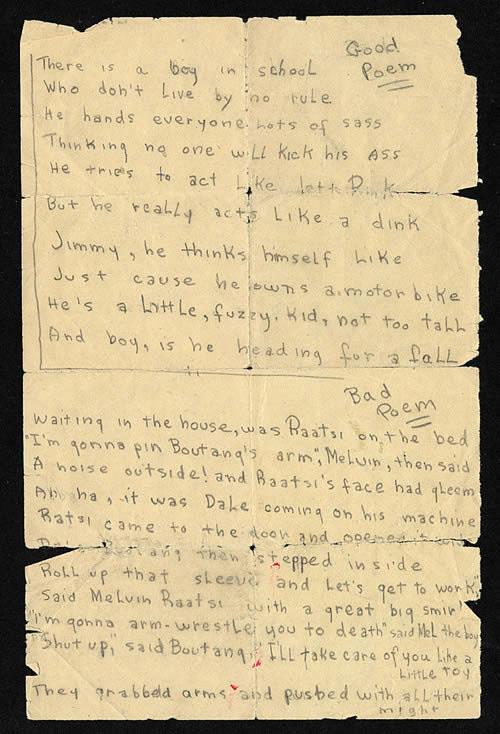
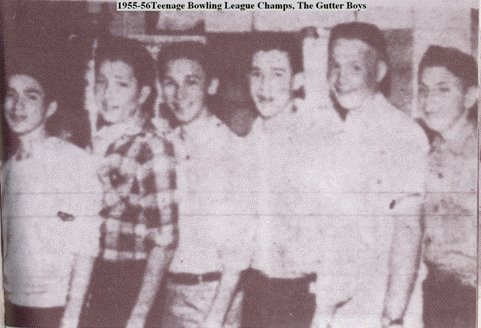
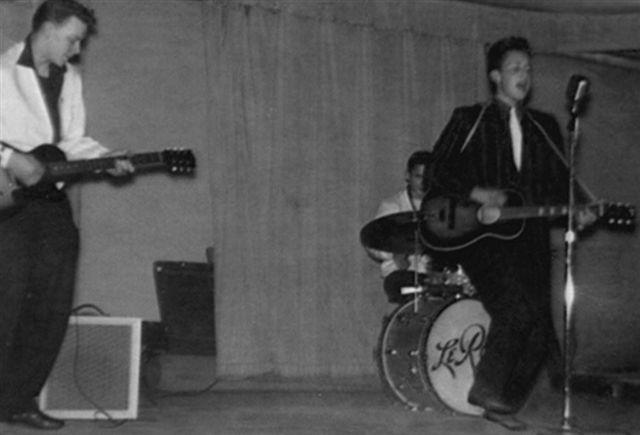
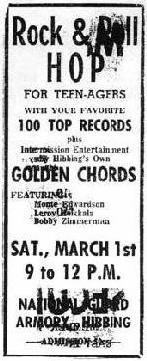
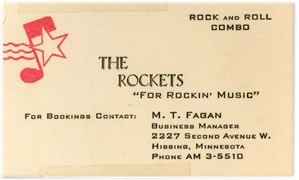
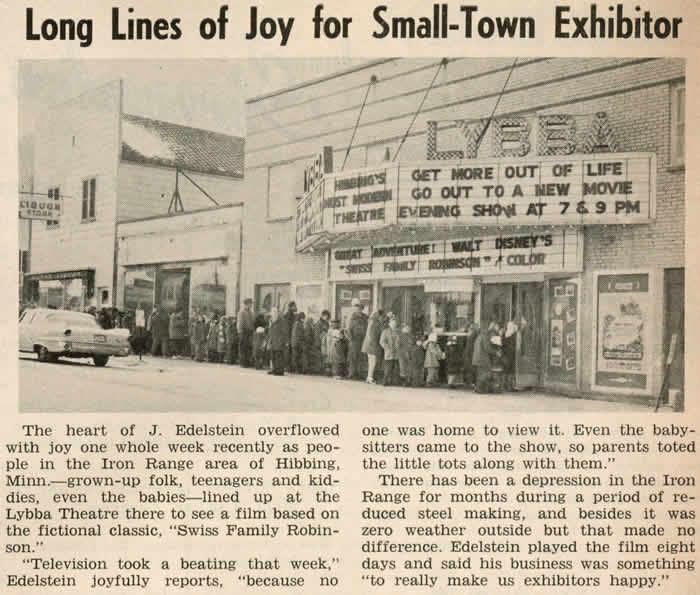
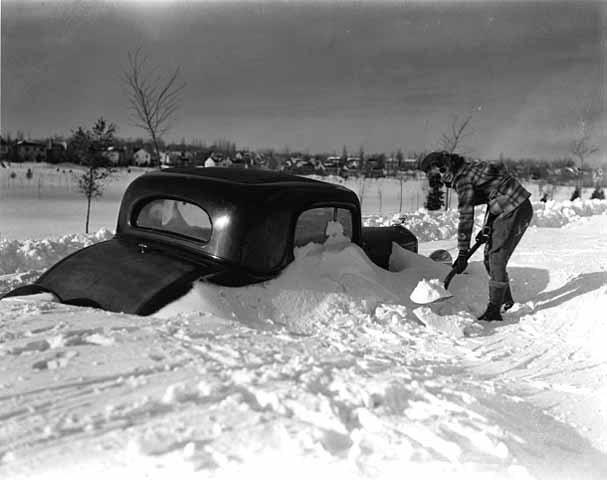
|
Racing Clinic for Hibbing Junior Chamber of CommercePhoto taken (circa) 1951? Prospective soapbox derby racer, Robert Zimmerman (2nd on right) wearing a billed-cap, lays hands on a steering wheel for his derby car. Did the racer get built? Did he race it? Is this the earliest known photograph of Bob in a hat?
"There is a boy in school
1955-1956 Teenage Bowling League ChampsThe Gutter Boys
The Golden ChordsMemorial Building, February 1958. Bob Zimmerman, with Monte Edwardson and LeRoy Hoikkala. “Bob had complete arrangements worked out in his head and he used us so that he could hear them come alive" LeRoy: “He would write a song right at the piano. Just chord it, and improvise on it. I remember that he sang one about a train in R&B style" During the Golden Chords days Bob, LeRoy and Monte worked out a song “Big Black Train”, the only Zimmerman-penned rock song known to exist. Monte Edwardson: “He wrote a thing called “Big Black Train”, that we used to do. At the time I couldn’t believe one of us could just write a song.
Well big black train, coming down the line Well I’ve been waiting for a long, long time
LeRoy Hoikkala: ”He changed a lot of songs. He listened to a song and he changed them. He didn’t like the way they read. Just like a lot of the songs he recorded. I use to say that he wasn’t copying someone, but he took the basic song and if he didn’t like the lyrics he just changed it to what he wanted.” John Bucklen: “It was difficult to tell which songs he wrote and which he didn’t write, because sometimes I’d discover that he said he wrote a song and he didn’t and other times I thought he did not write the song and he did. So, it was … pretty similar to the music we were interested in at the time.” LeRoy: “He was improvising quite a bit. He would copy a lot of songs. He’d hear a song and make up his own version of it. He did a lot of copying but he also did a lot of writing of his own. He would just kind of sit down and make up a song and play it a couple of times and then forget it. I don’t know if he ever put any of them down on paper.” “Big Black Train” was later, in fall of 1958, to be recorded by The Rockets at the Kay Banks studio in Minneapolis, for the Aladdin Record label, but never released. The Rockets was then Monte Edwardson, LeRoy Hoikkala, Jim Propotnick and Ron Taddei. “..and we finished it on the way to the recording studio”. A handful of acetates exists. “ … used the others to get played on the radio.” Bob 1965: “I never sang what I wrote until I got to be about eighteen or nineteen. I wrote songs when I was younger, fifteen, but they were songs. I wrote those. I never sang anything which I wanted to write. Y’understand? The songs I wrote at that age were just four chords rhythm and blues songs. Based on things that the Diamonds would sing, or the Crewcuts, or groups like that, the uh, the, you know,’In the still of the night’ kinda songs, you know.” For more about LeRoy Hoikkala and Monte Edwardson, see the Family and Friends page.
National Guard ArmorySaturday 1 March 1958. Saturday March 1, 1958, they played and got paid for a one-off performance at the intermission of a Rock & Roll Hop for Teen-Agers at the National Guard Armory, billed as ‘Hibbing’s Own Golden Chords Featuring Monte Edwardson, Leroy Hoikkala, Bobby Zimmerman’.
The RocketsOriginal Group : 1957-1958 Ron Taddei Then it changed to : Late 1958 Jim Propotnick The final make up was : early 1959 Dave Karakash The Rockets disbanded in late 1959.
Lybba Theatre.Swiss Family Robinson was released on 21 December 1960.
"... and the snow was outrageous"
|
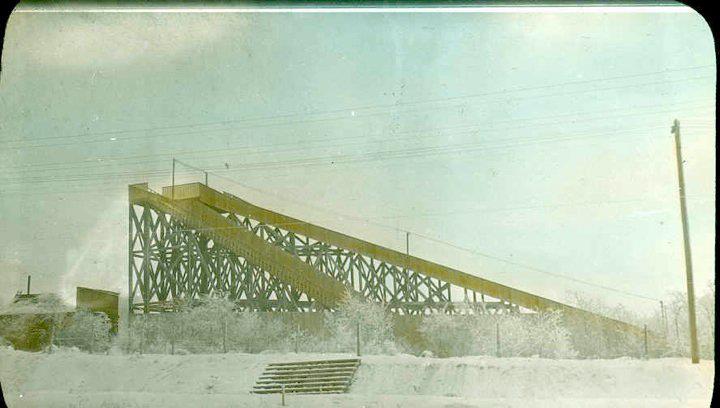
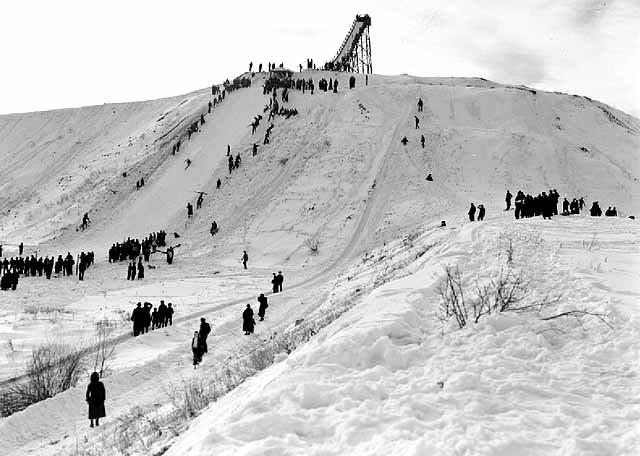
| Hibbing Toboggan Slide.Is this Pill Hill or an earlier one elsewhere? "There was one of these on Pill Hill in the 1950's. As a matter of fact, I went tobogganing there, several times, with my junior hight school friend, Bobby Zimmerman. On the same toboggan!! This may not be the same slide -- but it sure brings back memories. -- Sally McHale Davidson "Pill Hill" was started as an iron ore dump. It is located on Seventh Avenue and Twenty-Sixth Street which up the hill turns into Highland Park. In the winter, people could come up on the hill and use the toboggan slide that used to be there.
Ski Jump, near the Toboggan Slide.
|
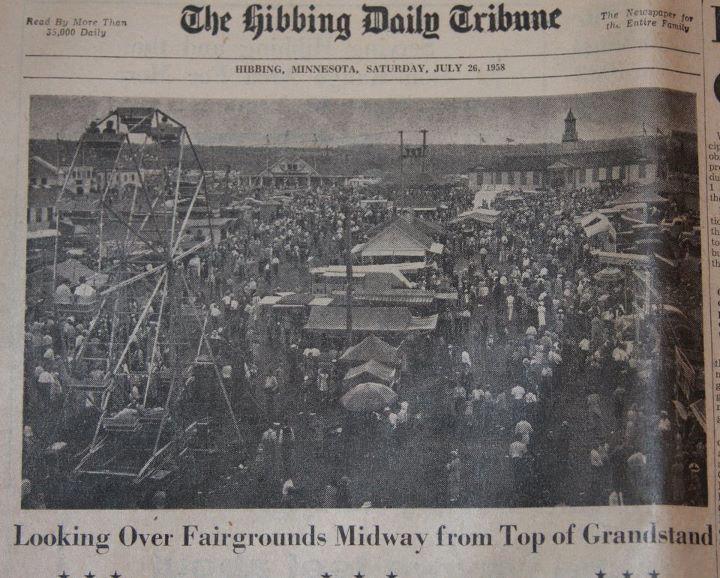
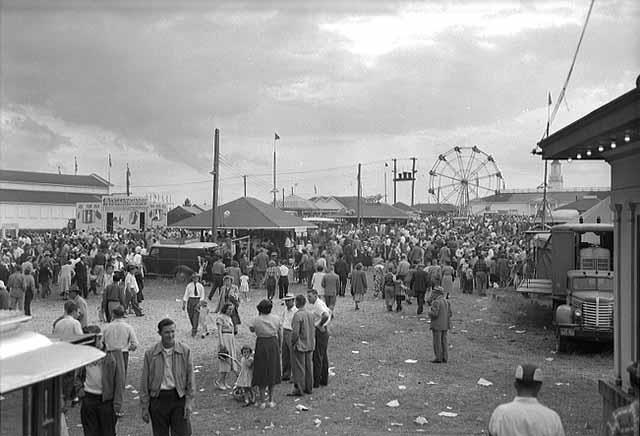

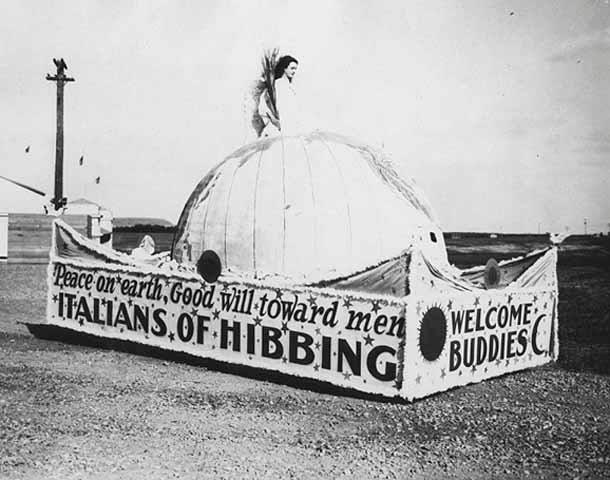


| St. Louis County Fair, HibbingNow, I come in on a Ferris wheel Lo and behold! Lo and behold!
St. Louis County Fair, HibbingWell, it’s all up from Florida at the start of the spring From the Michigan mud past the Wisconsin sun Hit Fargo on the jump and down to Aberdeen As the white line on the highway sails under your wheels It’s a-many a friend that follows the bend Oh, it’s pound down the rails and it’s tie down the tents Well, it’s roll into town straight to the fairgrounds Get the dancing girls in front, get the gambling show behind It’s a-drag it on down by the deadline in the town As the harmonicas whined in the lonesome nighttime And it’s roll back down to St. Petersburg Photographer: Al Heitman
St. Louis County Fair, Hibbing. Automobile racesPhotographer: Al Heitman GV3.84 r1 22763
Welcome Buddies!A Hibbing girl sure could wear a serious skirt or dress.
Saint Louis County Fair, HibbingWhat a show. A bear on a tight rope. Bicycles ready to go on the tightrope, ridden by humans or bears? Racing cars ready to race. All in front of Hibbing's bare breasts visible from space (also known as the world famous sewage works). And on the right...
... as we turn our heads to the right we see more than bears, bicycles and fast cars -- next we see high in the sky acrobats! In the distance. A mine shaft super-structure? No. It is one of the many ski jumps that were in various places around Hibbing.
|
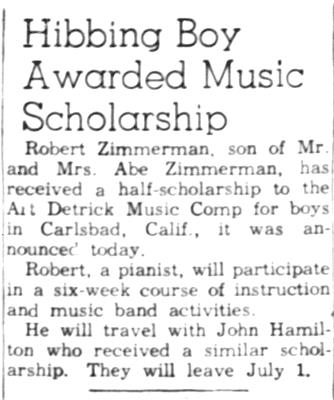
| What ever happened to John Hamilton? Hibbing Boy Awarded Music ScholarshipRobert Zimmerman, son of Mr. And Mrs Abe Zimmerman, has received a half-scholarship to the Art Detrick Music Comp [Camp] for boys in Carlsbad, Calif., it was announced today. Robert, a pianist, will participate in a six-week course of instruction and music band activities. He will travel with John Hamilton who received a similar scholarship. They will leave July 1. -- Hibbing Daily Tribune, 6 June 1960. What ever happened to John Hamilton? John did go to the camp. Later his band was called Little John and the Sherwood Men. He had blonde hair and a crew-cut? Rick Sundvick, Bill Berg and Jerry Phillips were in that band too. "It was around this time that Bob began playing music, for the Zimmermans had acquired a Gulbranson spinet piano. Beatty had played when she was young and Abe could pick out a tune, but the piano was bought mostly in the hope that the boys might show an interest. A cousin named Harriet Rutstein gave Bob and his six-year-old brother initial tutoring. "David, who was a very, very smart boy, took it all in ... and he could play better than Bob," says his uncle, Lewis Stone. "He was very musically inclined." Bob became frustrated and dispensed with his cousin's help, announcing, "I'm going to play the piano the way I want to." He proceeded to teach himself, and without ever learning how to read music. The boys were encouraged to take up other instruments, too. Bob tried the trumpet and saxophone before settling on acoustic guitar, working with the Nick Manoloff Basic Spanish Guitar Manual." http://www.nytimes.com/books/first/s/sounes-01highway.html David went on to do a degree in music at the University of Minnesota. Jeanne Hamilton informs us that, "Bob did not go - his brother Dave (who was a classmate of my brother, John) went - the article was mistaken." This rings true, the camp seemed unlikely for Bob in 1960. Indeed, John and Jeanne Hamilton's mother, Claribel "Trox" Hamilton, was Bob's first piano teacher! Presumably this was after Harriet Rutstein's informal tutoring...
|
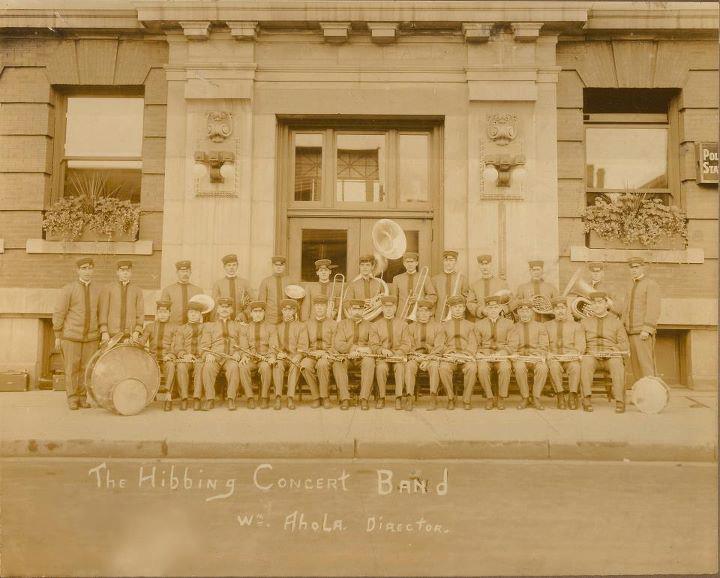
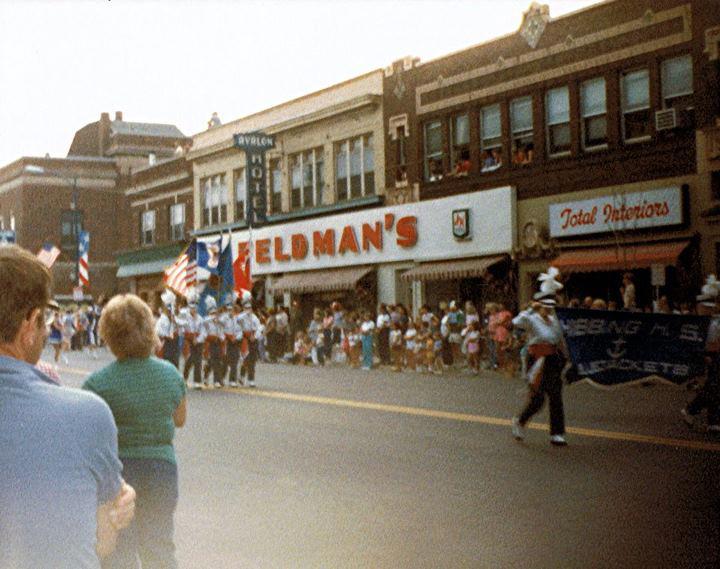
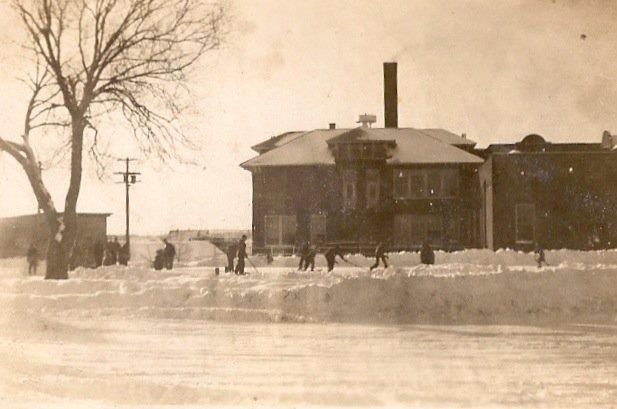
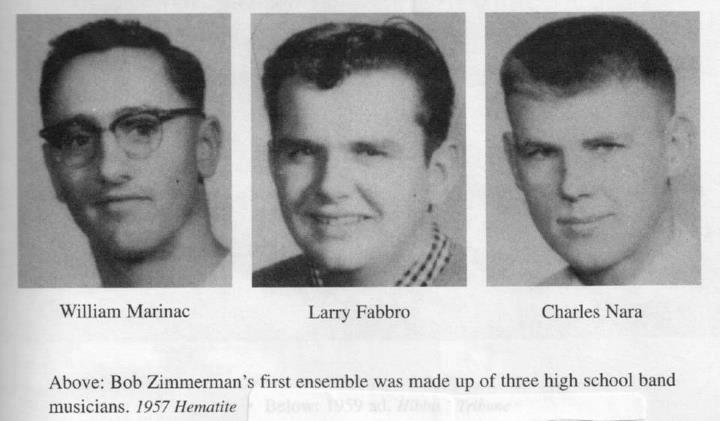
| The Band
The things I did growing up were the things I thought everybody did-march in parades, have bike races, play ice hockey.
"The things I did growing up were the things I thought everybody did-march in parades, have bike races, play ice hockey. (Not everyone was expected to play football or basketball or even baseball, but you had to know how to skate and play ice hockey.)" In winter Hibbing would have many ice rinks for skating and hockey, all you needed was snow banks, cold temperatures, running water and patience and you could make a rink. The Shadow Blasters (late 1956 – early 1957):Bob Zimmerman – vocals, piano The Jacket Jamboree Talent Festival – Junior High Student Council variety show (April 5, 1957), auditorium of Hibbing High School. There were two shows, one for the student body during school hours, a sort of dress rehearsal, and later an evening show for parents... The student council variety show April 5 announces that a local jazz "quintet," including Larry Fabbro, will perform. "Surprise numbers are also on the program, and there are rumors concerning a sensational novelty number which at the moment is top secret," announces Hi-Times. Everything Bob does is on the Q.T. until he does it. The boys slick their hair back and strap on sunglasses, sport coats and whatever pink shirt is available on a Broadway-styled stage … the four take their place before an audience of almost 2,000. From the audience's left, the band consists of Zimmerman on piano, Marinac on bass, Fabbro on guitar and Nara on drum and cymbal. When the act jolts into being, tittering follows like a reverberation. Little Bobby Zimmerman jumping around. Shouting, banging on the piano keys. At the grand piano, belting out two Little Richard tunes: "Jenny Jenny" Whoo! Jenny Jenny Whoo! Jenny Jenny and "True Fine Mama" Whoo! Honey honey honey honey honey honey honey. The only amplified instrument is Fabbro's guitar. It's all so loud and disorganized, he cannot follow the piano playing. The band forges ahead anyway. Most of the volume is provided by Bob's piano pounding. Among the audience are those who don't know whether to applaud or boo, whether to cover their eyes or their ears. Well, the boy has chutzpah, Marinac's bass teacher tells him. Whatever that means. Certainly, performing stirs Bobby's soul. To Fabbro, an involved student used to the stage, the event is little more than a lot of fun, something no one else is doing, something to make you feel hep. Chuck Nara: “We kind of did it originally as a lark and then it started getting serious. It got serious because of Bob. He was turned on by Little Richard and doing this singing. No other groups on the Range were doing anything like it.” Fabbro remembers "some very shocked people" at both performances, even the early one, attended only by the kids. Fabbro remembers it this way: "They thought it was a put on. They never heard anything like this before. In fact, even for us playing behind Bob the performance was a lot of noise more than anything else. It was hard for us to even understand the piano playing, it was so loud."
|
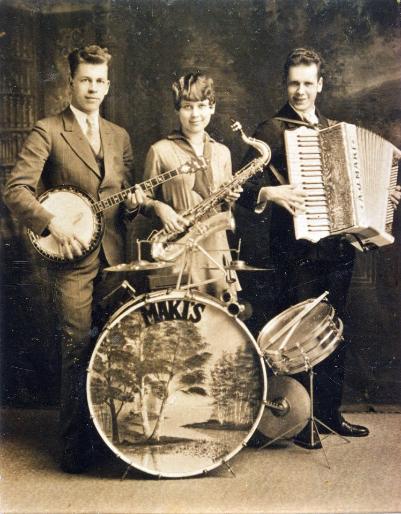
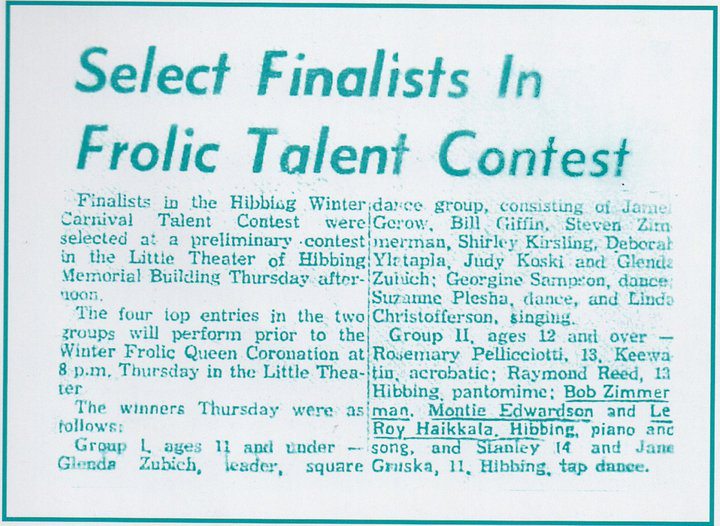
| The Maki Trio Famous Song & Dance OrchestraArvo Maki -- accordion, Signe Maki -- saxophone, Sulo Maki -- drums See: the Druid Maki gravestones with Eye of Horus symbol, on the Downtown page.
|
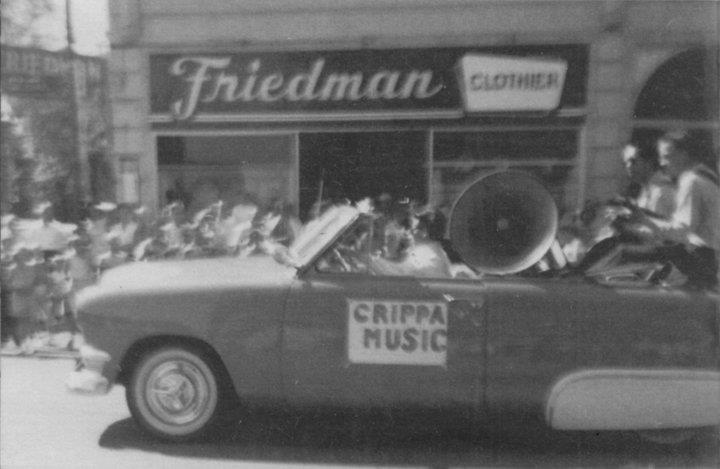
| Common practice for local promotion and raising awareness. The Rockets join a Howard Street parade to promote an appearance. The same technique of mobilized public performance for self-advertisement had previously been employed by The Golden Chords. -- Photograph courtesy of LeRoy Hoikkala. LeRoy Hoikkala in interview in On The Tracks #18: "The convertibles...Bob had a '54 Ford convertible, I had one also. They were used, but nice little cars. They were not expensive cars. We didn't have new cars. We used (our cars) to promote our dances or rock concerts. We would get these big speakers, horns and two big amplifiers on top of my convertible and we would sit there playing, to advertise our dances. You don't see that anymore!"
|
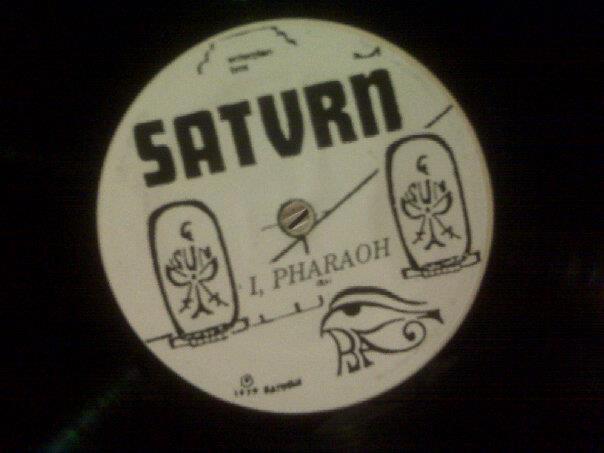
| I, Pharaoh / Sun Ra (El Saturn Records)Sun Ra's symbol would have been well known to young Bob Zimmerman. Sun Ra (born Herman Poole Blount, legal name Le Sony'r Ra (1914 – 1993) was a jazz composer, bandleader and piano player from Birmingham, Alabama. Ra is the ancient Egyptian sun god. He was associated with the falcon. In later Egyptian dynastic times, Ra was merged with the god Horus. Humans were created from Ra's tears.The sun is Ra's eye. Sun Ra and his band wore Egyptian-styled costumes and headdresses. These costumes were a part of Sun Ra's abiding fascination with ancient Egypt. Sun Ra denied any connection with his birth name, saying "That's an imaginary person, never existed … Any name that I use other than Ra is a pseudonym." From the mid-1950s to his death in 1993, Sun Ra led "The Arkestra", an ensemble with an ever-changing lineup. For decades, very little was known about Sun Ra's early life, much of it being obscured by Sun Ra himself. He routinely gave evasive, contradictory or seemingly nonsensical answers to personal questions and even denied his birth name. His birthday for years remained unknown. Tom Wilson, one of Bob's record producers, had started his career with his own record company -- Transition Records -- which had released Sun Ra's first vinyl LP. Sun Ra recorded dozens of singles and over one hundred full-length albums, comprising well over 1,000 songs, and making him one of the most prolific recording artists of the 20th century. As a synthesizer and electric keyboard player, Sun Ra ranks among one of the earliest and most radical pioneers. By the mid-1950s, he used a variety of electric keyboards, and almost immediately, he exploited their potential, sometimes modifying them himself to produce sounds. His live albums from the late 1960s and early 1970s feature some of the noisiest, most bizarre keyboard work ever recorded! Do you think Bob was influenced by Sun Ra? Maybe. ;-) |